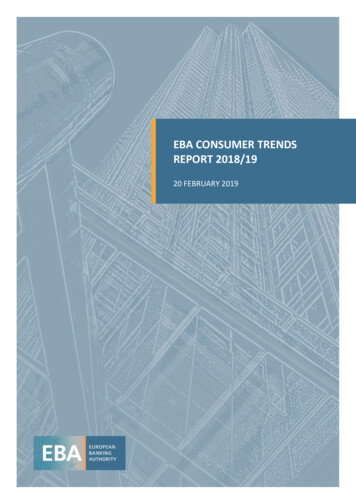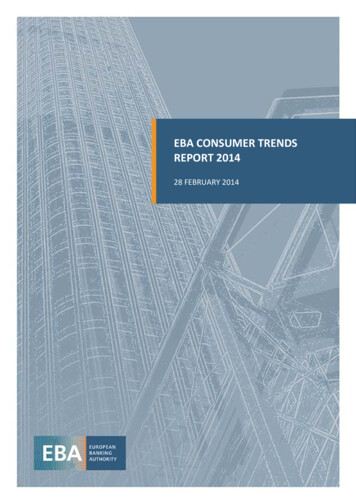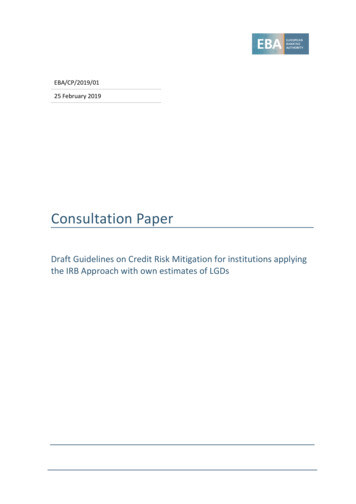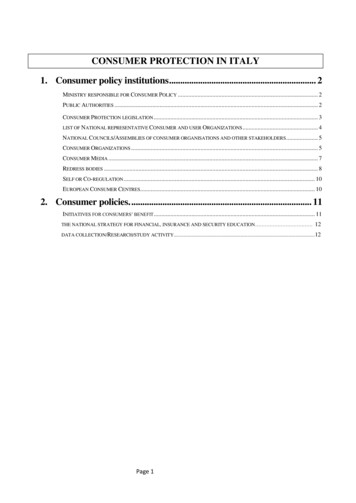
Transcription
EBA CONSUMER TRENDSREPORT 2018/1920 FEBRUARY 2019
EBA CONSUMER TRENDS REPORT 2018/19ContentsList of abbreviations3Figures5Table6Executive summary7Background10Chapter 1: Retail banking products and services12Mortgages12Consumer credit18Payment services and electronic money24Payment accounts34Deposits38Structured deposits42Chapter 2: Topical issues46Fees and charges46Indebtedness, responsible lending and creditworthiness assessment50Financial literacy and education57Transparency and disclosure of pre-contractual information and changes to contractual terms andconditions62Data breaches and cyber-security65Cross-border selling of products and services682
EBA CONSUMER TRENDS REPORT 2018/19List of abbreviationsADRalternative dispute resolutionAMLanti-money launderingAPRCannual percentage rate of chargeATMautomated teller machineCAcompetent authorityCCDConsumer Credit DirectiveCTRConsumer Trends ReportDGSdeposit guarantee schemeDGSDDeposit Guarantee Schemes DirectiveDSTIdebt-service-to-incomeEBAEuropean Banking AuthorityECBEuropean Central BankESAEuropean supervisory authorityESISEuropean Standardised Information SheetEUEuropean UnionFERFinancial Education ReportFIDfee information documentFIN-NETFinancial Dispute Resolution NetworkFinTechfinancial technologyITinformation technologyITSimplementing technical standardsKIDkey information documentLTIloan-to-income3
EBA CONSUMER TRENDS REPORT 2018/19LTVloan-to-valueMCDMortgage Credit DirectiveMiFID IIrevised Markets in Financial Instruments DirectiveMiFIRRegulation on Markets in Financial InstrumentsMSMember StateNPLnon-performing loanPADPayment Accounts DirectivePOSpoint of salePRIIPpackaged retail investment and insurance-based investment productPSD2revised Payment Services DirectivePSPpayment service providerRTSregulatory technical standardsSoFstatement of fees4
EBA CONSUMER TRENDS REPORT 2018/19FiguresFigure 1: Mortgages as a percentage of loans to households in EU MSs . 13Figure 2: Amounts (in euros) of lending for house purchases, 2013-2018 . 13Figure 3: Annualised rate of lending for house purchase in the euro area, 2008-2018 . 14Figure 4: Consumer credit, 2013-2017 (billion EUR, outstanding amounts) . 19Figure 5: Credit for consumption to all loans (outstanding amounts), 2013-2017 . 20Figure 6: Total number of payments per type of payment service (millions), 2013-2017 . 25Table 1: Total value of payments per type of payment instrument (billion EUR), 2013-2017 . 26Figure 7: Annual percentage changes in the number of payments, 2015-2017. 27Figure 8: Number of cards issued by resident payment service providers (thousands), 2013-2017. 27Figure 9: Percentage of adult EU citizens who used internet banking: individuals with low and highlevels of education who used internet banking, 2013-2017. 28Figure 10: Total number of ATMs provided by resident PSPs, 2014-2017 . 29Figure 11: Total number of POS terminals provided by resident PSPs, 2014-2017 . 30Figure 12: Electronic money issued in the euro area, 2013-2017 (billion EUR). 30Figure 13: Percentage of the population aged 15 years or over holding a payment account in theEU . 35Figure 14: Deposits by households and non-profit institutions, 2013-2017 (billion EUR,outstanding amounts) . 39Figure 15: Savings rate and interest rates in the EU, 2013-2017 . 40Figure 16: Relative importance of the topical issue ‘fees and charges’. 46Figure 17: Relative importance of the topical issue ‘indebtedness’ . 51Figure 18: Relative importance of the topical issue ‘responsible lending and creditworthinessassessment’ . 53Figure 19: Relative importance of the topical issue ‘financial literacy and education’ . 58Figure 20: Relative importance of the topical issue ‘transparency and disclosure of pre-contractualinformation and changes to contractual terms and conditions’. 63Figure 21: Relative importance of the topical issue ‘data breaches and cyber-security’ . 66Figure 22: Relative importance of the topical issue ‘cross-border selling of products and services’. 685
EBA CONSUMER TRENDS REPORT 2018/19TableTable 1: Total value of payments per type of payment instrument (billion EUR), 2013-20172666
EBA CONSUMER TRENDS REPORT 2018/19Executive summaryThe Founding Regulation of the European Banking Authority (EBA) requires it to collect, analyse andreport on consumer trends, which the EBA does in the form of its Consumer Trends Report (CTR),which is published regularly. The report covers the retail banking products and services that fallwithin the EBA’s consumer protection mandate, such as mortgages, consumer credit, deposits,payment accounts, payment services and electronic money. It reflects on the trends observed inthe European Union (EU) in respect of these products and services and on the issues identified bycompetent authorities (CAs) that may result in consumer detriment.This edition of the report identifies the following main findings for each of those products andservices: Mortgages have experienced a relatively steady increase in the past 5 years in both thevolume and the value of lending for property purchases across the EU. The main issues thatemerge are related to households’ indebtedness and lending practices, the level of fees,and challenges for early repayment and loan refinancing. Consumer credit has been relatively stable in the past 5 years, with a slight increase in creditfor consumption. The main issues arise from the cost of short-term credit, the misuse ofconsumer credit, poor creditworthiness assessment and insufficient contractual and precontractual information. Payment services and e-money have been characterised by payment cards continuing to bethe most widely used payment instrument, despite the increased use of digital and onlinepayment services. The main concerns identified are related to the application of theincoming security requirements to new payment services and solutions, the transparencyof fees and charges, and unauthorised and/or fraudulent payment transactions. Payment accounts have been characterised by a high percentage of the EU populationhaving access to these accounts, but the level of account management fees, the refusal toopen and the blocking of payment accounts are mentioned as frequent issues. Deposits are slightly decreasing, in line with a decline in the savings rate. The main issuesidentified are the negative impacts of the low interest rate environment, the level of themaintenance fees and financial institutions unilaterally revoking some contracts.The report also outlines the topical issues that the EBA has identified as being relevant toconsumers in the EU as identified by various stakeholders, including CAs, national and EU consumerassociations, the members of the Financial Dispute Resolution Network and EU industryassociations. The topical issues for this edition of the CTR are in order of relative importance, andidentify actions that the EBA and CAs may decide to carry out, taking into account relevantlegislative developments that the European Commission and/or EU co-legislators may be initiating.7
EBA CONSUMER TRENDS REPORT 2018/19 Fees and charges — as a result of decreasing interest rate income, fees and charges werereported to be used as an alternative revenue stream. The main issues identified relate tothe fees and charges on payment accounts, cost of payment services and cost of loans. TheEBA could assess the effectiveness of the regulatory measures undertaken to improve thetransparency and disclosure of information. Indebtedness, responsible lending and creditworthiness assessment — the risk ofconsumers’ over-indebtedness is fuelled by the low interest rate environment, poorcreditworthiness assessment practices, the use of multiple marketing channels andmisleading commercial practices. The EBA intends to assess these issues further to identifythe appropriate measures to ensure better outcomes for consumers. Financial literacy and education — the most relevant issues identified were the negativeconsequences stemming from the low level of financial education, as well as the need fortargeted education in relation to the new providers and complex services and tools used inthe financial market. While the EBA will continue monitoring the national financial literacyand education initiatives, financial institutions should provide consumers with appropriateinformation that is adjusted to their needs and financial situation. Transparency and disclosure of pre-contractual information and changes to contractualterms and conditions — the main concerns raised relate to the transparency of banking feesand costs, the disclosure of pre-contractual information to consumers, and the unilateralamendment of contractual terms and conditions by financial institutions. CAs and therelevant EU institutions, including where relevant the EBA, could assess whether theundertaken initiatives are effective and sufficient. Data breaches and cyber-security — the digitalisation of financial services may exposeconsumers to new risks and threats such as the risk of misuse of personal financial data andcyber-crime. While CAs should pay increased attention to these risks, the EBA aims tofacilitate cooperation between CAs and try to harmonise the approaches taken. Cross-border selling of products and services — the relevant issues identified were the lackof awareness of the actors involved in cross-border agreements and their responsibilitiesand redress mechanisms, and the lack of adequate enforcement powers by hostsupervisory authorities. The EBA aims to ensure effective cooperation between home andhost CAs in the supervision of the financial institutions providing cross-border services.Finally, a comparison with CTR 2017 suggests that, while some of the topical issues identified in thisedition of the CTR had already emerged, others are appearing for the first time.8
EBA CONSUMER TRENDS REPORT 2018/19Consumer Trends Report 2017Indebtedness (including ‘Commercial lendingpractices’ and ‘Household borrowing,creditworthiness assessment and arrearshandling’)Banking fees and costsSelling practices (cross-selling and salesincentives)Innovation in paymentsForeign currency loansAlternative financial services providersInnovative uses of consumer dataXXConsumer Trends Report 2018/19Indebtedness, responsible lending andcreditworthiness assessmentFees and chargesCross-border selling of products and servicesXXXData breaches and cyber-securityFinancial literacy and educationTransparency and disclosure of precontractual information and changes tocontractual terms and conditionsThe EBA intends to use the findings of the CTR 2018/19 as a basis when shaping its work programmein the consumer protection area for 2020 and beyond.9
EBA CONSUMER TRENDS REPORT 2018/19Background1.One of the mandates conferred on the EBA is to collect, analyse and report on consumertrends, as laid down in Article 9(1)(a) of the EBA Regulation 1. In order to fulfil this mandate,the EBA regularly publishes a Consumer Trends Report (CTR), and has done so in March 2013 2,February 2014 3, June 2015 4, June 2016 5 and June 2017 6.2.Each report sets out the trends and issues that the EBA has observed that year for the productsand services within its remit, identifies the topical consumer protection issues that arise orhave arisen for consumers and reflects on the initiatives that the EBA has taken in response oris considering for inclusion in its work programme for the following year(s).3.The CTR 2018/19 is the first biennial publication of the report. EBA plans to publish the reportevery 2 years in the future, mainly to allow sufficient time for the EBA to react on the issuesand trends identified and to avoid repetition of some topics, which tend to be recurring.4.The products and services that are covered in the EBA’s CTR comprise all retail bankingproducts and services that fall within the scope of action of the EBA’s consumer protectionmandate. This includes mortgages, consumer credit 7, payment services and electronic money,payment accounts and deposits (including structured deposits). This edition of the report,which covers the years 2018 and 2019, sets out the trends and issues that the EBA hasidentified and analysed from a consumer protection perspective.5.The CTR 2018/19 is primarily based on the consumer protection priorities identified bynational competent authorities (CAs) in the 28 EU Member States (MSs). Further input wasreceived from a selection of national and EU consumer associations, the members of theFinancial Dispute Resolution Network (FIN-NET) and EU industry associations. All of thesestakeholders were asked to name the topical issues they had observed and the trends andrelated issues that they therefore considered the EBA should address in 2020 and beyond. Thiswas further complemented by the EBA’s analysis of statistical datasets and reports, producedby public sources, such as Eurostat, the European Central Bank (ECB) and the World Bank, onmarket developments across various categories of financial services.6.The 2018/19 edition of the report differs from previous reports in that it uses additionalsources of information and is more detailed and more comprehensive. As before, however,the report is split into two sections. Chapter 1 covers the retail banking products and services1Regulation (EU) No 1093/2010 establishing an European Supervisory Authority (European Banking Authority). DF/?uri CELEX:02010R1093-20160112&from EN.2See trends-report.3See trends-repo-1.4See -trends-in-2015.5See Consumer Trends Report 2016.pdf.6See onsumer Trends Report 2017.pdf.7Provided by credit institutions only.10
EBA CONSUMER TRENDS REPORT 2018/19within the scope of action of the EBA’s consumer protection mandate and that are thereforemonitored by the EBA.7.The information on retail banking products and services comprises a short introduction to theproduct/service, the applicable EU legal and regulatory framework, the evolution of theproduct/service, the observed trends, relevant complaints data from CAs and FIN-NETmembers, and the most common issues relevant to the product or service. Where relevant,reference is made to the initiatives that the EBA and the national CAs are carrying out inrelation to these products and services. The report, however, does not reflect all supervisoryactivities that may have been undertaken by CAs to address the issues identified.8.The report also provides a summary of how the EBA has fulfilled its separate mandate underArticle 39(2) of Regulation (EU) No 600/2014 on Markets in Financial Instruments (MiFIR) 8 tomonitor the market for structured deposits which are marketed, distributed or sold in theUnion.9.Chapter 2 outlines topical issues that the sources have identified as relevant to the EBA. Theseissues tend to vary between the editions of the report, which reflects the varying inputsreceived over time and from the different sources consulted by the EBA. The topics include‘Fees and charges’, ‘Indebtedness, responsible lending and creditworthiness assessment’,‘Financial literacy and education’, ‘Transparency and disclosure of pre-contractual informationand changes to contractual terms and conditions’, ‘Data breaches and cyber-security’ and‘Cross-border selling of products and services’.10. As highlighted in Chapter 2, while the topical issues of ‘Fees and charges’ and ‘Indebtedness,responsible lending and creditworthiness assessment’ recur from the previous edition of thereport (2017), others, such as ‘Data breaches and cyber-security’ and ‘Cross-border selling ofproducts and services’, have slightly changed. The other topical issues identified in the CTR2018/19 have not been covered in the last few editions of the report.11. The description of the topical issues consists of a brief introduction of the topic and its relativeimportance, the relevant issues that have been identified as arising from the topic across theEU, and the regulatory and/or supervisory measures the EBA and CAs have already undertakento address some of the relevant issues. In addition, the EBA has identified for each topical issueactions that the EBA and CAs may decide to carry out, taking into account relevant legislativedevelopments that the European Commission and/or EU co-legislators may be initiating.8Regulation (EU) No 600/2014 Regulation on Markets in Financial Instruments.11
EBA CONSUMER TRENDS REPORT 2018/19Chapter 1: Retail banking products andservices12. This section covers the retail banking products and services within the scope of action of theEBA’s consumer protection mandate. These products and services are monitored by the EBAand feature in every edition of the report. These include mortgages, consumer credit, paymentservices and electronic money, payment accounts and deposits. In addition, the report coversstructured deposits in fulfilment of the EBA’s separate mandate under MiFIR to monitor themarket for structured deposits which are marketed, distributed or sold in the EU.MortgagesIntroduction13. Mortgage loans are offered by credit institutions, building societies or other lenders and areoften secured against a consumer’s property. A mortgage loan usually comes with a lowerinterest rate and a longer redemption period than other types of consumer credit. However,if a consumer fails to fulfil their repayment obligations and their mortgage has been securedagainst their property, lenders may be in a position to seize and resell the consumer’s hometo pay off the loan. Lenders are free to accept or reject a consumer’s mortgage application 9.14. Taking out a mortgage loan is likely to be one of the most important financial decisions aconsumer will make in their lifetime 10. ‘On average, around 1 in 4 Europeans [sic] householdscurrently has a mortgage loan — however, in some [European] countries [.], more than halfof the population (not only home-owners) are mortgage holders’ 11. Mortgages continue to bethe most common form of collateral that is used for housing loans across the EU.Evolution and trends15. Mortgages have a big impact on consumers’ personal finances, representing in excess of 77%of loans to households in EU MSs in 2017 (see Figure 1). There has been a small but steadyincrease in the percentage of loans ( 69 basis points) being drawn down for house-purchasingpurposes, up from 76.8% in June 2016 to 77.4% in June 2018.9European Union’s consumer web pages. See nancial-productsand-services/mortgages/index en.htm.10EMF-ECBC Mortgage Guide for Consumers. See onsumer-guide/.11European Mortgage Federation, EMF-ECBC: Celebrating 50 years of funding the real economy — benefits of mortgageand housing markets. See -eu/.12
EBA CONSUMER TRENDS REPORT 2018/19Figure 1: Mortgages as a percentage of loans to households in EU 016AprJulOct2017JanAprJun2018Source: ECB.Note: 26 EU MSs, excluding Denmark and Sweden.16. Lending for house purchases rose in a steady upwards trajectory, from EUR 5.85 trillion inJanuary 2016 to EUR 6.08 trillion in January 2018, representing an increase of EUR 229 billionin that 2-year period (see Figure 2).MillionsFigure 2: Amounts (in euros) of lending for house purchases, Jan-2016Jan-2017Jan-2018Source: ECB.Note: 27 EU MSs, excluding Denmark.17. There has been a relatively steady increase in both the volume (Figure 1) and the value(Figure 2) of lending for house purchases across the EU over the past 5 years (2013-2018). Asignificant number of CAs also reported an increase in the volume and value of new mortgagedrawdowns in their jurisdictions.13
EBA CONSUMER TRENDS REPORT 2018/1918. Figures 1 and 2 indicate that, while consumers in the EU drew down more mortgages in 2017and the first half of 2018 than in 2016, this increase in lending to households for housepurchases, in terms of both volume and value, has been quite modest. It is worth noting thatthe modest increase in mortgage drawdowns on average across the EU masks the fact that thisoverall trend was not observed in all EU MSs. A small number of CAs noted a reduction in thenumber of mortgage agreements concluded in their countries. In addition, based on theinformation assessed, it was not possible to determine the extent to which the ‘newmortgages’ reported represent entirely new lending or existing loans that have beenrestructured, and thus are considered ‘new mortgages’ from a contractual perspective.19. The annualised agreed rate of lending or the cost of borrowing for house purchases fell from5.3% in June 2008 to 1.8% in June 2018 (see Figure 3). The annualised agreed rate of lendingfor house purchases has remained relatively constant since 2017 (around 1.8% in 2017 and2018). This may imply that borrowing funds for consumers to buy their own home is likely tobe less costly than it was in 2008.20. Based on the data presented in Figure 3, the overall cost of borrowing for home purchasesacross the euro area as a whole should have decreased over the past 10 years because of thedecrease in the rate of lending for house purchases. However, this figure does not reflect thedifferences that continue to exist between euro area countries in respect of consumers’ accessto, and the availability of, affordable mortgage credit. Consumers in some euro area countriescontinue to find it more costly or difficult to borrow for home purchase than consumers inother euro area countries, which are less affected by the legacy of the financial crisis. This isconsidered further in this report, both in the ‘Relevant issues’ sub-section related to mortgagesand in the topical issue ‘Indebtedness’ that is covered in Chapter 2 of this report.Figure 3: Annualised rate of lending for house purchase in the euro area, 2008-201865% per 020112012201320142015201620172018Source: ECB.Legal and regulatory framework14
EBA CONSUMER TRENDS REPORT 2018/1921. For the purpose of this report, ‘mortgages’ are understood, in the context ofDirective 2014/17/EU on credit agreements for consumers relating to residential immovableproperty (the Mortgage Credit Directive, MCD) as credit agreements, entered into byconsumers, which are secured either by a mortgage or by another comparable securitycommonly used in an MS of the European Union on residential immovable property and usedto acquire or retain property rights in land or in an existing or projected building.22. The purpose of the MCD, which was to be incorporated into Member States’ national law by21 March 2016, is to develop a more transparent, efficient and competitive internal EUmarket, through consistent, flexible and fair credit agreements relating to immovableproperty, while promoting sustainable lending and borrowing practices, and financialinclusion, thus providing a high level of consumer protection.23. Among other things, the MCD places an obligation on lenders to assess a consumer’screditworthiness in accordance with common EU standards, and for consumers to be providedwith a European Standardised Information Sheet (ESIS) setting out detailed information on theconditions, including the consumer’s right to repay their credit earlier than determined in thecontract (‘early repayment’). The MCD also introduces requirements for the calculation of theannual percentage rate of charge (APRC).24. The entry into force of the MCD across the EU in 2016 also brought about the introduction ofa number of Level 2 and 3 measures developed by the EBA, which supplemented or clarifiedsome of the provisions contained in the MCD itself. These include: Regulatory Technical Standards (RTS) on the Minimum Monetary Amount ofProfessional Indemnity Insurance or comparable guarantee to be held by creditintermediaries under the MCD (EBA/RTS/2014/08). These RTS specify the amount ofthe professional indemnity insurance or comparable guarantee that mortgage creditintermediaries need to hold. This is a measure that provides consumers with greaterprotection in the event of a claim. An EBA decision specifying the benchmark rate under the MCD (EBA/DC/2016/145). Incertain circumstances, creditors must use this benchmark rate to calculate theillustrative examples for variable rate mortgages. These illustrations must be providedto consumers on the ESIS. EBA Guidelines on Creditworthiness Assessment (EBA/GL/2015/11) supplementingArticles 18 and 20(1) of the MCD. These guidelines provide greater detail on howconsumers’ creditworthiness is to be assessed by creditors. EBA Guidelines on Arrears and Foreclosure (EBA/GL/2015/12) supplementingArticle 28 of the MCD by requiring creditors to exercise reasonable forbearance beforestarting foreclosure proceedings.15
EBA CONSUMER TRENDS REPORT 2018/19Relevant issuesQuick take-awaysCAs reported the following common issues for consumers arising from mortgages, which areelaborated in detail below: levels of household indebtedness;concerning lending practices;level of fees and charges, and their transparency;challenges for early repayment of a mortgage loan;mortgage loan refinancing.25. The most common issues related to mortgages raised by CAs, applicable to the majority of theMSs, are the level of indebtedness of consumers, including the effect of the low interest rateenvironment, and responsible lending practices. A number of CAs also reported issues relatedto the fees and charges applied to consumers when drawing a mortgage. These topics areconsidered in greater detail in Chapter 2 of this report because, while closely linked todevelopments in the EU mortgage market, they are also relevant to other retail bankingproducts and services that fall within the scope of action of the EBA’s consumer protectionmandate.26. A large number of CAs have identified as an issue in their jurisdictions the challengesencountered by consumers willing to repay their mortgage early, including the imposition ofunreasonable delays. Pursuant to Article 25 of the MCD, consumers have a right to repay theirmortgage earlier under certain conditions that may vary from MS to MS. In a number of MSs,creditors may seek fair and objective compensation for costs directly linked to the earlyrepayment from consumers who wish to exercise this right; however, sanctions should not beimposed on consumers who choose to repay their mortgage early. Nevertheless, the costsimposed on consumers who exercise their right to early repayment represent an issue forseveral CAs.27. A number of CAs noted that consumers have engaged in mortgage loan refinancing or havechosen to repay their existing mortgage loan early, so that they could capitalise on the lowerinterest rate environment. Several CAs reported that consumers appear to have restructuredtheir mortgage in arrears so that they could afford to meet their mortgage repaymentobligations, albeit at a lower rate, and/or renegotiate their outstanding loans by combiningthem with their mortgage. A few CAs indicated that credit institutions were unwilling torenegotiate the terms and conditions associated with an existing loan agreement or presentedconsumers with unfavourable refinancing terms and conditions, presumably in an effort toencourage the consumer not to look to break their existing mortgage agreement.28. A few CAs observed an increase in the popularity of fixed interest rate mortgages amongconsumers in their jurisdictions in recent years, though variable rate mortgages continue to be16
EBA CONSUMER TRENDS REPORT 2018/19very common among consumers across most of the MSs. Individual CAs reported that (i) therewere some initial indications to suggest that the trend of an increase in fixed interest ratemortgages may be coming to an end, perhaps in response to the expected increase in thevariable interest rate in the near future; (ii) the gap between spreads on fixed and variable rateloans is an issue; and (iii) the cost of drawing down mortgage loans can significantly varybetween MSs because of the difference in the levels of the variable rates, which subsequentlyaffects the cost of the mortgage.29. Mu
trends, as laid down in cleArti 9(1)(a) of the EBA Regulation 1. In order to fulfil this mandate, the EBA regularly publishes a Consumer Trends Report (CTR), and has done so in March 2013 2, February 2014 3, June 2015 4, June 2016 5 and June 2017 6. 2. Each report sets out the trends and issues that the EBA has observed that year for the products










